Themed collection Size Selected Clusters and Particles: From Physical Chemistry to Catalysis

Size selected clusters and particles: from physical chemistry and chemical physics to catalysis
The physicochemical and catalytic properties of matter can change dramatically and in an unexpected fashion as particle sizes increase from single atoms to small subnanometer sized clusters to particles nanometers in size.
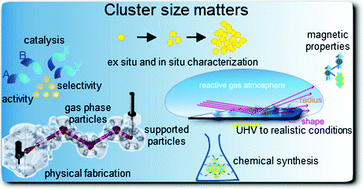
Phys. Chem. Chem. Phys., 2014,16, 26418-26420
https://doi.org/10.1039/C4CP90163K
The control of Pt and Ru nanoparticle size on high surface area supports
Supported Ru and Pt nanoparticles were synthesized by the method of strong electrostatic adsorption and subsequently treated to achieve a series of catalysts with particle sizes ranging from 1 to 8 nm. This methodology allows the control of particle size applicable to high surface area supports with common metal precursors.
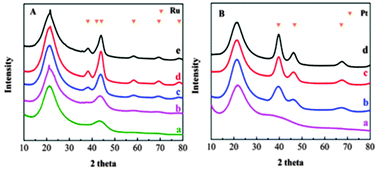
Phys. Chem. Chem. Phys., 2014,16, 26431-26435
https://doi.org/10.1039/C4CP02714K
Copper clusters as novel fluorescent probes for the detection and photocatalytic elimination of lead ions
A new homogeneous assay for a fast, selective and sensitive detection and elimination of lead ions has been developed using copper clusters as novel fluorescent probes in aqueous solutions.
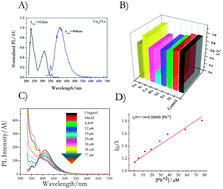
Phys. Chem. Chem. Phys., 2014,16, 26427-26430
https://doi.org/10.1039/C4CP02148G
Structure and magnetic properties of (Fe2O3)n clusters (n = 1–5)
Global minimum structures of (Fe2O3)n clusters (n = 1–5) determined for the first time in this size range show weak dependence of the structure and relative stabilities of different isomers on their magnetic states.
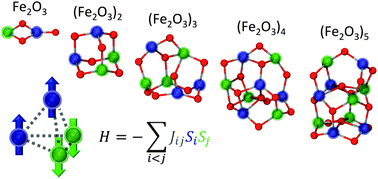
Phys. Chem. Chem. Phys., 2014,16, 26421-26426
https://doi.org/10.1039/C4CP02099E
Parallel deposition of size-selected clusters: a novel technique for studying size-selectivity on the atomic scale
A new size-selected cluster deposition technique referred to as “parallel-deposition” is presented.
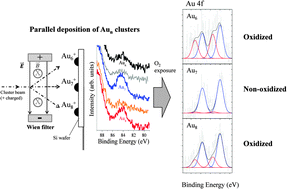
Phys. Chem. Chem. Phys., 2014,16, 9233-9237
https://doi.org/10.1039/C4CP00931B
Bis(μ-oxo) versus mono(μ-oxo)dicopper cores in a zeolite for converting methane to methanol: an in situ XAS and DFT investigation
The zeolite framework stabilizes the mono(μ-oxo)dicopper core, which is the active species in methane to methanol conversion.
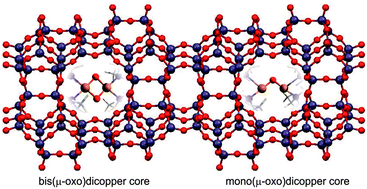
Phys. Chem. Chem. Phys., 2015,17, 7681-7693
https://doi.org/10.1039/C4CP03226H
Theoretical examination of solvent and R group dependence in gold thiolate nanoparticle synthesis
The reaction of phenylthiol with AuCl4− yields gold thiolate nanoparticle precursors in polar solvents.
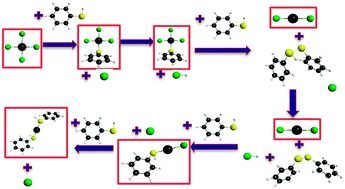
Phys. Chem. Chem. Phys., 2015,17, 7676-7680
https://doi.org/10.1039/C4CP04314F
Self-organisation of size-selected CoxPt1−x clusters on graphite
Submonolayer thin films morphologies obtained by deposition of size-selected CoxPt1−x clusters on graphite have been analyzed for different values of x. We put into evidence that the introduction of platinum atoms in the incident particles drastically changes the interaction between clusters and a local self-organization of size selected magnetic nanoparticles can be achieved.
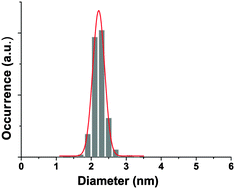
Phys. Chem. Chem. Phys., 2014,16, 26653-26657
https://doi.org/10.1039/C4CP02119C
A near ambient pressure XPS study of subnanometer silver clusters on Al2O3 and TiO2 ultrathin film supports
We have investigated model systems of silver clusters with different sizes (3 and 15 atoms) deposited on alumina and titania supports using ambient pressure X-ray photoelectron spectroscopy.

Phys. Chem. Chem. Phys., 2014,16, 26645-26652
https://doi.org/10.1039/C4CP02325K
Optimised photocatalytic hydrogen production using core–shell AuPd promoters with controlled shell thickness
AuPd shell–Au core promoters with controlled shell thickness supported on titanium dioxide improve the photocatalytic hydrogen production.
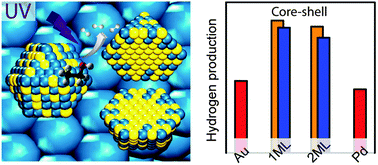
Phys. Chem. Chem. Phys., 2014,16, 26638-26644
https://doi.org/10.1039/C4CP04693E
The effects of 1-pentyne hydrogenation on the atomic structures of size-selected AuN and PdN (N = 923 and 2057) nanoclusters
An investigation into the effects of the vapour-phase hydrogenation of 1-pentyne on the atomic structures of size-selected Au and Pd nanoclusters.

Phys. Chem. Chem. Phys., 2014,16, 26631-26637
https://doi.org/10.1039/C4CP02686A
In situ magnetic and electronic investigation of the early stage oxidation of Fe nanoparticles using X-ray photo-emission electron microscopy
In situ X-ray photoemission electron microscopy reveals the evolution of chemical composition and magnetism of individual iron nanoparticles during oxidation.
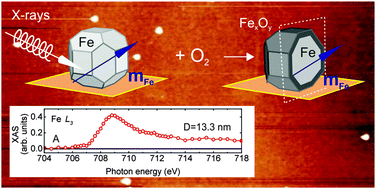
Phys. Chem. Chem. Phys., 2014,16, 26624-26630
https://doi.org/10.1039/C4CP02725F
Highly regioselective hydride transfer, oxidative dehydrogenation, and hydrogen-atom abstraction in the thermal gas-phase chemistry of [Zn(OH)]+/C3H8
The metal center of [Zn(OH)]+ serves as active site in the regiospecific hydride transfer to generate [i-C3H7]+ as major product in the reaction with C3H8. In the [Zn(OH)]+–C3H8 system, a high regioselectivity features the remarkable chemoselectivity.
![Graphical abstract: Highly regioselective hydride transfer, oxidative dehydrogenation, and hydrogen-atom abstraction in the thermal gas-phase chemistry of [Zn(OH)]+/C3H8](/en/Image/Get?imageInfo.ImageType=GA&imageInfo.ImageIdentifier.ManuscriptID=C4CP02139H&imageInfo.ImageIdentifier.Year=2014)
Phys. Chem. Chem. Phys., 2014,16, 26617-26623
https://doi.org/10.1039/C4CP02139H
Platinum–hydrogen vibrations and low energy electronic excitations of 13-atom Pt nanoclusters
Infrared spectra confirm that hydrogen forms bridged bonds along the edges of 13-atom platinum clusters.
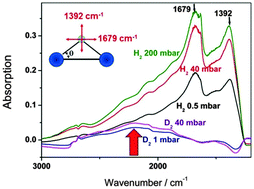
Phys. Chem. Chem. Phys., 2014,16, 26613-26616
https://doi.org/10.1039/C4CP02052A
Water activation by small free ruthenium oxide clusters
Water efficiently reacts with small free ruthenium oxide clusters via internal hydrogen shift.

Phys. Chem. Chem. Phys., 2014,16, 26578-26583
https://doi.org/10.1039/C4CP02366H
Propene epoxidation with O2 or H2–O2 mixtures over silver catalysts: theoretical insights into the role of the particle size
O2 activation and dissociation become more difficult over subnanometric silver clusters, but selectivity towards propene epoxidation does not improve.
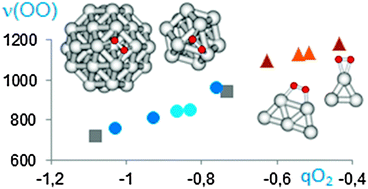
Phys. Chem. Chem. Phys., 2014,16, 26600-26612
https://doi.org/10.1039/C4CP02198C
Computational studies of electrochemical CO2 reduction on subnanometer transition metal clusters
Computational studies of electrochemical reduction of CO2 were carried out using tetra-atomic transition metal clusters.
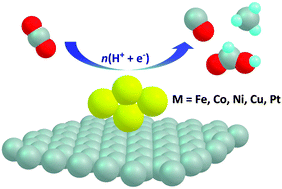
Phys. Chem. Chem. Phys., 2014,16, 26584-26599
https://doi.org/10.1039/C4CP02690J
The structural and electronic properties of Aun clusters on the α-Al2O3(0001) surface: a first principles study
We report the structural and electronic properties of Aun (n =1–7 and 10) clusters supported on clean α-Al2O3(0001) surface using first principles approach. To underscore the effect of support interaction, the geometries of the deposited Au clusters are compared with their gas-phase structures.
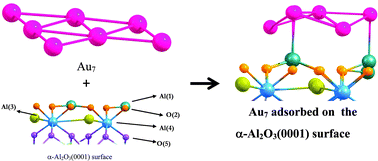
Phys. Chem. Chem. Phys., 2014,16, 26561-26569
https://doi.org/10.1039/C4CP02137A
Ligand/cluster/support catalytic complexes in heterogeneous ultrananocatalysis: NO oxidation on Ag3/MgO(100)
The Ag3(CO3)/MgO(100) complex transforms in the presence of NO and O2 into a highly active Ag3(CO3) (NO2)2/MgO(100) NOox catalyst.
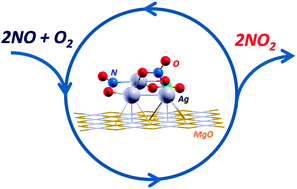
Phys. Chem. Chem. Phys., 2014,16, 26570-26577
https://doi.org/10.1039/C4CP02135E
Selective hydrogenation of butadiene over TiO2 supported copper, gold and gold–copper catalysts prepared by deposition–precipitation
The Au1Cu3/TiO2 catalyst shows an increase in butadiene selective hydrogenation conversion, assigned to copper segregation at the surface of bimetallic particles.
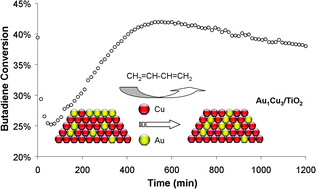
Phys. Chem. Chem. Phys., 2014,16, 26514-26527
https://doi.org/10.1039/C4CP02141J
Exploring the phase space of time of flight mass selected PtxY nanoparticles
Mass distribution, morphology and chemical composition critically affect the catalytic properties of PtxY nanoparticles.
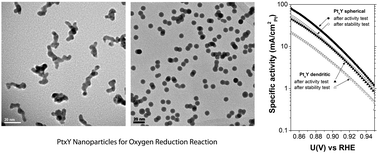
Phys. Chem. Chem. Phys., 2014,16, 26506-26513
https://doi.org/10.1039/C4CP02144D
Catalytic oxidation of CO with N2O on isolated copper cluster anions
The gas-phase catalytic cycle of CO oxidation with N2O takes place on Cun−, and proceeds most efficiently at n = 7.
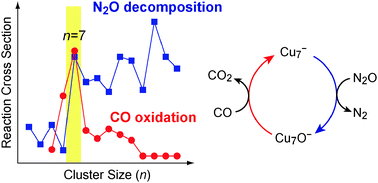
Phys. Chem. Chem. Phys., 2014,16, 26500-26505
https://doi.org/10.1039/C4CP01554A
Atomically dispersed rhodium on a support: the influence of a metal precursor and a support
The type of metal precursor and support affects rhodium dispersion. The combination of X-ray absorption and electron microscopy analysis allowed quantification of the amount of atomically dispersed rhodium over catalysts.
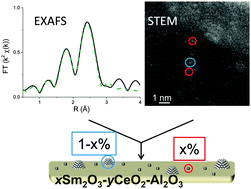
Phys. Chem. Chem. Phys., 2014,16, 26553-26560
https://doi.org/10.1039/C4CP02596B
Illuminating surface atoms in nanoclusters by differential X-ray absorption spectroscopy
We use differential extended X-ray absorption fine structure (Δ-EXAFS) to monitor the Ar-induced surface restructuring of silica-supported Pd nanoclusters (1 nm diameter) at 77 K.
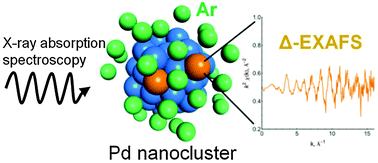
Phys. Chem. Chem. Phys., 2014,16, 26528-26538
https://doi.org/10.1039/C4CP02146K
Ab initio studies of propene epoxidation on oxidized silver surfaces
Pathways for propene oxide, acrolein and propanone formation on oxidized silver surfaces are studied using DFT simulations.
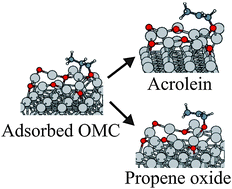
Phys. Chem. Chem. Phys., 2014,16, 26546-26552
https://doi.org/10.1039/C4CP02103G
DFT studies of oxygen dissociation on the 116-atom platinum truncated octahedron particle
Oxygen dissociation studies performed on Pt116 nanoparticles highlight the importance of surface flexibility for fast reaction kinetics.
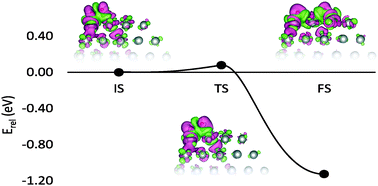
Phys. Chem. Chem. Phys., 2014,16, 26539-26545
https://doi.org/10.1039/C4CP02147A
Systematic study on novel catalytic activity of CO oxidation driven by strong electronic interaction between the monatomic-layered Pt30 cluster disk and the Si substrate
Temperature-programmed-desorption spectra of 13C16O18O catalytically produced by the monatomic-layered Pt30 cluster disk strongly bonded to the Si(111) surface.
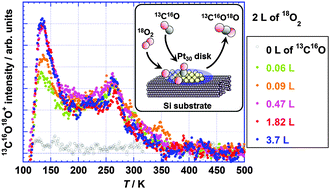
Phys. Chem. Chem. Phys., 2014,16, 26493-26499
https://doi.org/10.1039/C4CP02221A
Chemical ordering in magic-size Ag–Pd nanoparticles
Equilibrium Ag–Pd nanoparticles have a Ag-rich surface, and a Pd-rich subsurface layer.
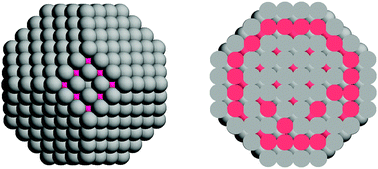
Phys. Chem. Chem. Phys., 2014,16, 26478-26484
https://doi.org/10.1039/C4CP02143F
Morphology and chemical states of size-selected Ptn clusters on an aluminium oxide film on NiAl(110)
Size-selected Ptn clusters on the Al2O3 surface form two-dimensional planar structures at n ≤ 18 and three-dimensional two-layer structures start to appear at n ≥ 19. They are composed of neutral and cationic Pt atoms.
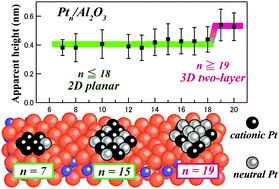
Phys. Chem. Chem. Phys., 2014,16, 26485-26492
https://doi.org/10.1039/C4CP01767F
Iron cluster–CO bond energies from the kinetic energy dependence of the Fen+ (n = 4–17) + CO association reactions
The first experimentally determined binding energies for CO to gas-phase metal clusters in any charge state approach bulk phase values.
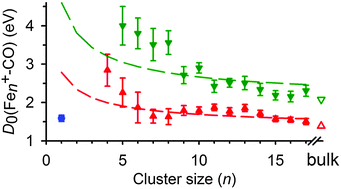
Phys. Chem. Chem. Phys., 2014,16, 26467-26477
https://doi.org/10.1039/C4CP02040E
Regular arrays of Pd and PdAu clusters on ultrathin alumina films for reactivity studies
Regular arrays of Pd and PdAu clusters with tunable size and composition supported on nanostructured alumina usable as model catalysts.
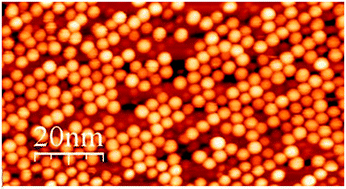
Phys. Chem. Chem. Phys., 2014,16, 26458-26466
https://doi.org/10.1039/C4CP02200A
Oxygen activation and CO oxidation over size-selected Ptn/alumina/Re(0001) model catalysts: correlations with valence electronic structure, physical structure, and binding sites
The catalytic properties of atomically size-selected Ptn clusters (n = 1, 2, 4, 7, 8, 9, 10, 14, 18) supported on alumina/Re(0001) are investigated and correlated to their physical and electronic structures.
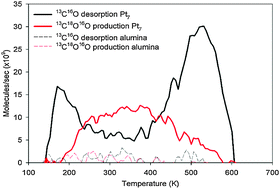
Phys. Chem. Chem. Phys., 2014,16, 26443-26457
https://doi.org/10.1039/C4CP02083A
Pure and Zn-doped Pt clusters go flat and upright on MgO(100)
Pure and Zn-doped Pt clusters on magnesia go flat and covalent, and stand upright.
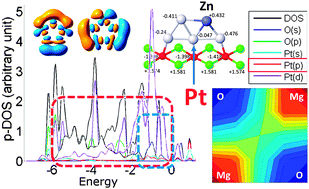
Phys. Chem. Chem. Phys., 2014,16, 26436-26442
https://doi.org/10.1039/C4CP01877J
Hydrogen mimicking the properties of coinage metal atoms in Cu and Ag monohydride clusters
A systematic study of the electronic structure and equilibrium geometries of Cun, Cun−1H, Agn, and Agn−1H; n = 2–5 clusters is carried out using photoelectron spectroscopy (PES) experiments and density functional theory based calculations.

Phys. Chem. Chem. Phys., 2013,15, 21007-21015
https://doi.org/10.1039/C3CP53561D
About this collection
Ultrasmall clusters and particles consist of dominantly under-coordinated surface atoms, but the ratio of facet to corner and edge atoms increases with growing size. The variety and controllability of surface or binding-site atoms offers an excellent tuning knob to optimize binding, reactivity and catalytic properties. Moreover, small particles facilitate reaction pathways that are not feasible on extended rigid surfaces, because they can undergo dynamical structural changes.
This themed issue, guest edited by Jeroen van Bokhoven (Institute for Chemical and Bioengineering ETH Zurich) and Stefan Vajda (Argonne National Laboratory), aims to address the need for the fundamental understanding of the evolution of physicochemical and catalytic properties of matter starting with small subnanometer size clusters that consist of only a handful of atoms, up to particles nanometers in size.